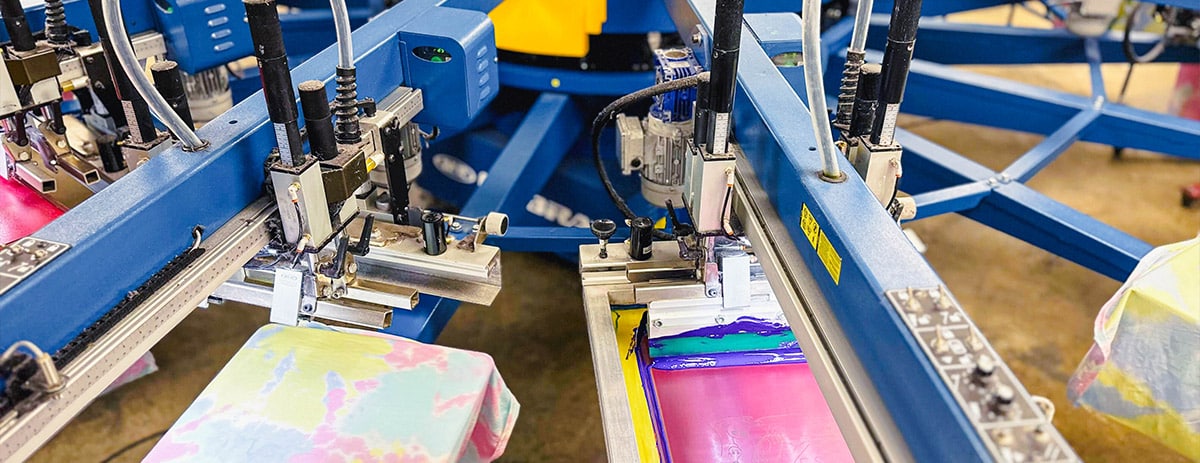Professional Screen Printing Kit for Custom Apparel
Professional Screen Printing Kit for Custom Apparel
Blog Article
Screen Printing Uncovered: Whatever You Need to Understand About Tee Shirt and Garment Printing Methods
Screen printing is an interesting approach that integrates art with strategy, providing countless opportunities for imagination. Prepared to check out the vital components that make screen printing an art form?
The Basics of Display Printing: How It Functions
When you plunge right into screen printing, you'll uncover it's both a science and an art. At its core, screen printing involves producing a pattern, or screen, that enables ink to pass with only in certain areas.
Next, you'll blend your inks and prepare your printing surface area. Placement the display over the textile, after that use a squeegee to push ink with the display onto the garment. This procedure requires precision, as you desire clear, vibrant prints. After printing, you'll treat the ink with warmth, guaranteeing it sticks to the fabric and lasts through cleans. Each step is vital, and mastering them will certainly elevate your display printing skills, changing straightforward garments into special, meaningful items.
Sorts Of Screen Printing Techniques
Once you realize the fundamentals of display printing, it's time to check out the different strategies that can raise your designs. One prominent method is typical display printing, where ink is pushed via a stenciled display. This strategy is great for strong, dynamic colors. Then there's water-based ink printing, which supplies a softer feeling and is environment-friendly, yet it requires a different technique to treating.
Another choice is plastisol printing, recognized for its resilience and vivid colors, making it a favorite for many brands. Experiment with halftone printing to create gradient effects and elaborate designs.
Vital Tools for Screen Printing
To achieve stunning cause display printing, having the appropriate tools is essential. Initially, you'll require a durable screen printing frame, which holds the mesh that transfers your layout onto the garment. Next, buy top notch squeegees; these are crucial for applying ink evenly across the screen. You'll additionally need an excellent exposure system to produce your screens, as well as a washout cubicle for cleaning them after usage. A trustworthy heat resource, like a conveyor dryer or warmth press, is crucial for treating your prints to assure durability. Don't neglect a proper workspace, outfitted with tables and storage for your products. Lastly, protective gear, such as gloves and masks, will certainly keep you secure from chemicals and inks. With the right devices, you'll be well on your way to producing professional-quality prints.
Selecting the Right Inks and Products
When choosing inks and products for screen printing, you require to take right into account the sort of ink that works finest for your task. Think of textile compatibility to guarantee your designs look fantastic and last lengthy. Likewise, explore environmentally friendly ink alternatives to make your printing process more sustainable.
Kinds of Screen Inks
Selecting the appropriate screen ink is essential for attaining lively, sturdy prints that meet your task's demands. There are a number of kinds of screen inks to check out. Specialized inks, such as metallic or glow-in-the-dark, can include distinct impacts to your layouts.

Textile Compatibility Considerations
Recognizing textile compatibility is important for attaining high-grade display prints, especially since different materials respond uniquely to numerous inks. Always check your inks on sample material to ensure they stick appropriately and maintain color honesty. In addition, keep in mind that material weight and appearance can influence the final outcome, so selecting the ideal ink and product combination is vital for your job's success.
Eco-Friendly Ink Options
Green inks are becoming a popular choice for display printers that want to minimize their environmental impact while preserving top quality. When picking inks, take into consideration water-based inks, which are much less hazardous and easier to clean up compared to traditional solvents.
Furthermore, try to find inks made from renewable energies, such as soy or vegetable-based alternatives. By choosing the ideal inks and products, you'll not only create spectacular styles however likewise contribute to a much more lasting printing process. Make the switch, and your prints will mirror your commitment to the environment!
Preparing Your Design for Screen Printing

File Style Requirements
To assure your design looks vivid and sharp on textile, you'll need to pay close focus to submit style requirements for screen printing. Start with vector files like AI or EPS, as they can be scaled without losing high quality. If you utilize raster photos, select high-resolution documents, such as TIFF or PNG, preferably at 300 DPI. Avoid utilizing JPEGs, as they can shed clarity when resized. Additionally, make sure your design has a clear history to avoid unwanted white edges on your prints. Ultimately, keep shade modes in mind; CMYK is conventional for display printing, so transform your RGB makes as necessary. By adhering to these standards, you'll set your artwork up for an effective print.
Color Splitting Up Strategies
Shade separation is a necessary step in page preparing your design for display printing, and mastering it can significantly improve your print high quality. You'll require to break your style into private colors, as each color calls for a separate display during printing. This accuracy not only assures accurate color representation yet likewise simplifies the printing process.
Resolution and Dimension
Achieving the ideal lead to display printing starts with assuring your design has the appropriate resolution and size. Preferably, your artwork must be at the very least 300 DPI (dots per inch) for sharp, clear prints. If you make use of reduced resolution, your end product may look unprofessional and pixelated.
When it pertains to size, think about the measurements of your print location. Design your art work to match the final print size, preferably developing it in the actual measurements you'll be publishing. In this manner, you'll prevent any kind of unexpected scaling problems.
Constantly examine your design in both vector and raster formats. Vector graphics can be scaled without losing quality, making them ideal for screen printing. Preparing properly will ensure your style looks remarkable on every garment!
Step-by-Step Display Printing Refine
Display printing is a vibrant procedure that enables you to develop vibrant designs on different surfaces. To start, you'll need a screen, solution, and your picked ink. Prepare your screen by cleaning it thoroughly. Next, apply the emulsion evenly and let it dry in a dark location. When completely dry, reveal your display to light with go your design put on it, which will certainly solidify the emulsion where the light hits, developing a pattern - screen printing kit.
After rinsing the unexposed solution, your display prepares. Establish it up on your printing surface area and straighten your garment beneath it. Put ink onto the screen and use a squeegee to press the ink via the pattern onto the material. Lift the display thoroughly and let the print dry. Heal the ink utilizing heat to assure toughness. That's it! You have actually effectively screen published your style.
Tips for Successful Screen Printing Projects
While you're diving into your display printing jobs, keep in mind that preparation is vital to success. Beginning by gathering all your products-- inks, garments, squeegees, and screens. A clean work space helps avoid unwanted errors, so tidy up prior to you start.
Next, verify your artwork is high-resolution and appropriately sized for your garment. Evaluate your display for appropriate direct exposure and clean it completely to stay clear of smudges. When blending your inks, follow the maker's standards to achieve the ideal consistency.
During printing, use even stress with your squeegee for regular results. Do not hurry; take your time to confirm each print meets your requirements. After printing, allow your garments dry totally before managing or packaging them.
Last but not least, always keep an example of your work for future recommendation. In this manner, you can evaluate your progression and boost your strategies with time. Pleased printing!

Often Asked Questions
How much time Does It Require To Establish up a Screen Printing Task?
Establishing up a screen printing job normally takes around half an hour to an hour. You'll prepare the displays, mix inks, and change the press. The time varies based upon intricacy and experience, so stay organized!
Can I Print on Various Textile Enters Utilizing the Exact Same Technique?
Yes, you can print on various textile types using the very same technique, but you'll require to change your settings and inks. Some textiles soak up ink in different ways, so exploring assurances the very best outcomes for each and every product.
What Are Typical Mistakes to Prevent in Display Printing?
When display printing, stay clear of typical blunders like utilizing the wrong ink, disregarding proper direct exposure times, or skipping pre-press checks. Constantly evaluate your arrangement and preserve clean displays to guarantee top quality results each time.
Just How Can I Effectively Clean and Maintain My Screen Printing Equipment?
To appropriately clean and keep your screen printing tools, you must regularly clean screens with appropriate solvents, examine squeegees for wear, and ensure all tools are kept dust-free and completely dry. Consistency enhances and stops pricey repair work efficiency.
Is Display Printing Eco-friendly Compared to Various Other Methods?
Screen printing can be a lot more environmentally pleasant than various other techniques, specifically if you use water-based inks and eco-conscious materials. By picking sustainable materials and techniques, you decrease waste and decrease your effect on the planet.
Screen Printing Uncovered: Whatever You Required to Know Regarding T-Shirt and Garment Printing Methods
At its core, display printing involves creating a stencil, or screen, that permits ink to pass with only in particular locations. Placement the screen over the fabric, after that make use of a squeegee to press ink with the screen onto the garment. One prominent method is standard screen printing, where ink is pushed through a stenciled screen.When choosing inks and materials for screen printing, you need to take into account the type of ink that works finest for review your project.
Report this page